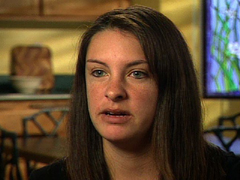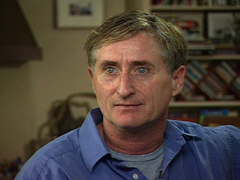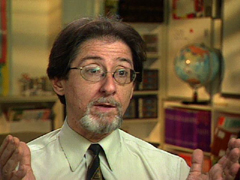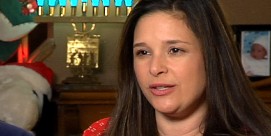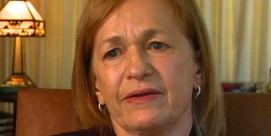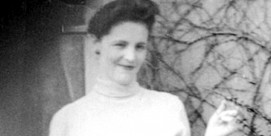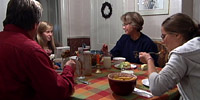In This Episode << SLIDE LEFT TO SEE ADDITIONAL SEGMENTS
Open Adoption
SAUL GONZALEZ: It’s a scene captured in countless home movies: a mother in the hospital with her newborn infant. But this mom, Sarah Kastner, isn’t keeping her son named Bo. Twenty years old, single and worried she’s not ready to raise a child, Sarah’s giving her baby up for adoption, personally passing him on to his new adoptive parents just after she gives birth.
SARAH KASTNER: You think, “Oh, yeah, baby is going to be cute, and everyone is going to help you.” But it’s, like, you have that child for 18 years. This kid is going to be needing to go to school. He’s going to be needing to go to college. You have to do medical bills if he gets sick, and it’s, like, there’s no way right now if I’m still, like, barely supporting myself. How I’m going to support this little baby and give him everything he needs in life?
GONZALEZ: Although she’s giving him up, Sarah’s playing a critical role in Bo’s future. That’s because Sarah’s chosen what’s called an open adoption. It allows a birth parent, often the mom, to choose the people who will adopt the child and, if she wishes, stay in contact with the adoptive parents and the child.
For Bo, Sarah picked John and Loren Halleran of Los Angeles. When they first considered adopting after years of trying without success to have their own child, the Hallerans assumed they’d have little to no contact with their adopted child’s birth parent or even know her identity. That’s called a closed adoption.
JOHN HALLERAN: We thought, you know, the mother—she has the baby, she never sees it again. You know, cut 20 years down the road, there’s this search for the birth parent, and it could go really well or really badly.
GONZALEZ: Kind of like a movie-of-the-week story?
Mr. HALLERAN: Exactly.
GONZALEZ: Like other birth mothers involved in open adoptions, Sarah reviewed dozens of personal profiles and appeals written by prospective adoptive parents before settling on the Hallerans.
(to Ms. Kastner): How many birth parent letters did you get?
Ms. KASTNER: Probably like 75 to 85, and it was like a big stack.
GONZALEZ: When you got that stack of 75 to 85—
Ms. KASTNER: It was overwhelming. It was, like, oh, my gosh, I’m going to change one of these people’s lives.
GONZALEZ: Sarah was struck by the Hallerans’ honesty in their letter to her.
Ms. KASTNER: I liked how it said by no means are we perfect, but we want to honor your commitment of how open you want this to be. So that was something that I liked.
GONZALEZ: Although her legal rights as a parent have been terminated, Sarah plans on a continuing relationship with Bo and his adoptive parents. Weeks after the birth, and living four hours drive away from each other, technology allows Sarah to see Bo regularly.
Mr. HALLERAN (speaking in computer conversation): I think he got to be like at least 10 or 12 pounds now. He’s getting heavy. He’s ready for pre-school.
Ms. KASTNER (responding): I thought we weren’t going to have a fat kid. What happened?
GONZALEZ: Staying in touch with Bo is important to Sarah, and not only because she’s his birth mom. Sarah herself was given up for adoption when she was an infant and was raised by an adoptive family. Like many other adoptees, Sarah grew up having no contact with her birth mother. That absence created questions.
Ms. KASTNER: I kind of do wish I knew my birth mom growing up a little bit, just so she’d, like, check in, and it’s like, “Oh, hey,” because it makes you feel like you just weren’t given up. If the birth mom does check in on you, she does care about me, and she does care about my well being. She just didn’t just dump me and start a new life and not ever think about me.
GONZALEZ: So that closing of the door completely between you and Bo was never an option?
Ms. KASTNER: Yeah, no, it wasn’t. Because I would always wonder, and I think it would drive me nuts always thinking, “What is he doing now? What is he going do to tomorrow and stuff? Like, oh, is he gaining weight? Is he okay? Is everything fine with him?” Yeah.
GONZALEZ: Open adoption relationships can range from an occasional exchange of photos and emails between birth parents and adoptive families to regular visits. The Hallerans believe Bo will only benefit from having contact with Sarah.
LOREN HALLERAN: Bo will always know, always know his birth mother. He will always know that he was placed out of love. that it was never, ever a question of not being wanted, but more an issue of Sarah wanting more than she could provide at this time.
GONZALEZ: The open adoption movement, which started in the 1980s, has largely transformed the culture of infant adoption in the United States. Experts say open adoptions have helped remove the anxieties of adoptive families and the shame of birth parents.
ADAM PERTMAN (Author, “Adoption Nation”): We didn’t used to talk about this stuff. This was all considered secret or private.
GONZALEZ: Adam Pertman is the author of “Adoption Nation” and the director of a nonprofit institute that’s dedicated to improving adoption practices.
Mr. PERTMAN: We really transformed it, right? It has gone from a stigmatized, still too often stigmatized, very secretive process — I mean people didn’t tell their own kids they were adopted, and that was more a norm whether they told their kids or not, it was not a subject for public conversation — to one in which it is a subject for public conversation. And I think that’s a very, very good thing, because we keep secrets about things that we are ashamed of and embarrassed about.
GONZALEZ: Pertman cites an American Psychological Association study released last year which concluded open adoptions helped mitigate birth parents’ feelings of pain and loss. But some in the adoption community believe there’s still a place for secrecy—sometimes because the birth parents want to remain anonymous, other times because of safety.
(to Kerri Dunkelberger): Are there occasions where it is a good thing to simply close the door on the biological parents or the biological parent?
KERRI DUNKELBERGER (Executive Director, Foster & Adoptions, Olive Crest Foster Family Agency): Yes. Yes. Absolutely, and we’ll work with the child’s attorney to say either it works in a counseling center or it doesn’t happen at all.
GONZALEZ: Kerri Dunkelberger is the director of adoption and foster care programs for Olive Crest, a charity that works to place often abused children with families. Although she supports open adoption, she says some birth parents are simply too dangerous to have contact with adoptive families.
Ms. DUNKELBERGER: We want the child to have as much information around that experience and honest information as possible. But there are case scenarios where either there is an incarceration, or it’s not a safe family, or it would somehow put the children or the entire family at risk where the biological family cannot be included.
GONZALEZ: Because the biological family could be a threat to the child or the adoptive parents?
Ms. DUNKELBERGER: Right. Right.
GONZALEZ: As families and experts wrestle with just how “open” open adoptions should be, other concerns persist. They include the widespread reluctance to adopt older or minority kids, the growing commercialization of the adoption process, and the rising price tag of adoption, with some adoptions costing upwards of $30,000.
Mr. PERTMAN: I think when you put human beings and dollar signs in the same sentence you are walking on perilous ground, and so I think that in many ways, many ways, money has supplanted secrecy as adoption’s own worst enemy.
GONZALEZ: Sarah Kastner feels too many people still believe birth parents who give up their child for adoption do it out of neglect or apathy.
Ms. KASTNER: You give him up for adoption out of love, not out of, like, selfishness, that you just don’t want to be responsible, and I think that’s what a lot of people don’t understand. Like, I have had to explain that a lot. I benefited so much from being adopted, and so I know Bo is going to benefit. Nothing bad can come from adoption.
For RELIGION & ETHICS NEWSWEEKLY, I’m Saul Gonzalez in Los Angeles.

